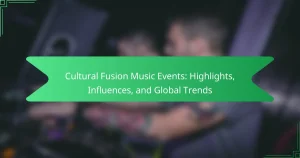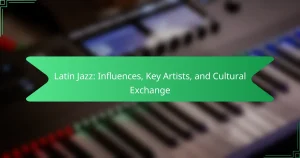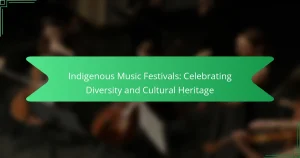Flamenco Fusion combines traditional Flamenco with diverse musical styles, creating unique interpretations and cultural exchanges. This article explores key techniques, notable artists like Rosalía and Vicente Amigo, and the genre’s cultural significance. It also addresses the challenges artists face in blending innovation with authenticity and examines the evolving perceptions of Flamenco Fusion across different cultural contexts. Finally, it looks ahead to future trends in the genre, including the integration of electronic music and collaborative efforts.
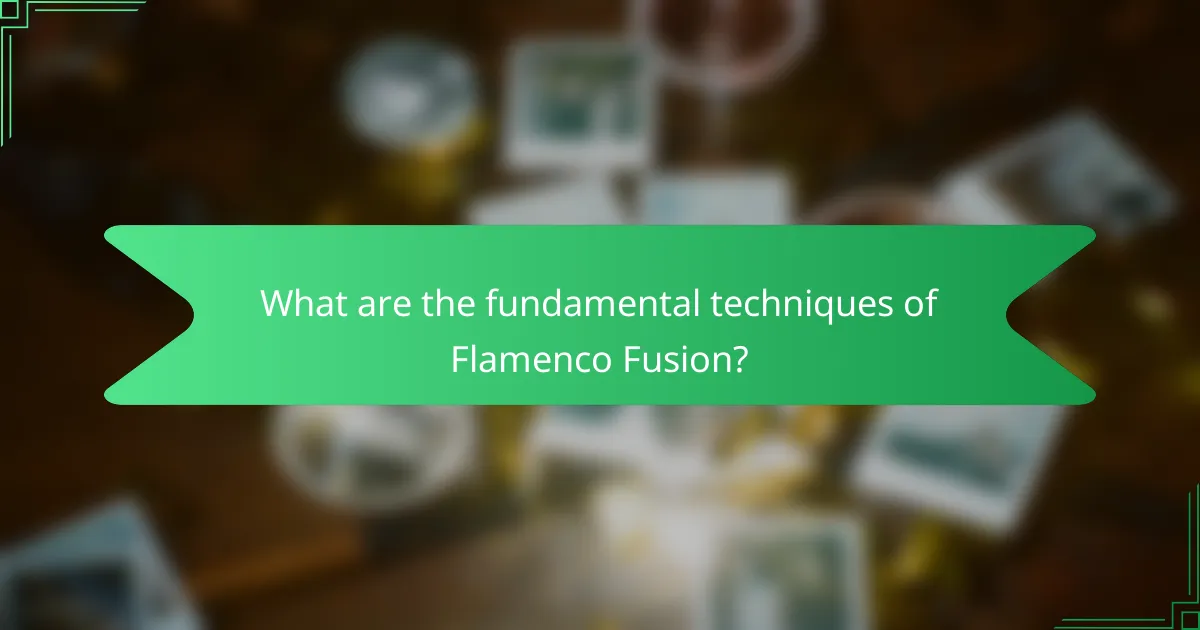
What are the fundamental techniques of Flamenco Fusion?
Flamenco Fusion incorporates various techniques that blend traditional Flamenco with other musical styles. Key techniques include innovative guitar playing, rhythmic footwork, and expressive body movements. Artists often experiment with improvisation, integrating elements from jazz, pop, and world music. This fusion allows for unique interpretations and cultural exchanges, enhancing the genre’s dynamic nature. The cultural significance lies in its ability to connect diverse audiences through shared musical experiences.
How do traditional Flamenco techniques integrate with modern styles?
Traditional Flamenco techniques integrate with modern styles through innovative rhythms and collaborations. Artists blend traditional footwork and hand clapping with contemporary genres like jazz and pop. This fusion creates a dynamic sound, enhancing emotional expression. Notable artists, such as Vicente Amigo and Estrella Morente, exemplify this integration, pushing Flamenco’s cultural significance into new realms. The unique attribute of improvisation in Flamenco allows for personal expression, making each performance distinct. As a result, Flamenco continues to evolve while honoring its rich heritage.
What role does improvisation play in Flamenco Fusion performances?
Improvisation plays a crucial role in Flamenco Fusion performances by enhancing creativity and spontaneity. It allows artists to blend traditional Flamenco techniques with diverse musical influences, creating unique interpretations. Improvisation fosters a dynamic interaction between musicians and dancers, enriching the overall performance experience. This adaptability is a key attribute that distinguishes Flamenco Fusion from traditional Flamenco, making it a vibrant and evolving art form.
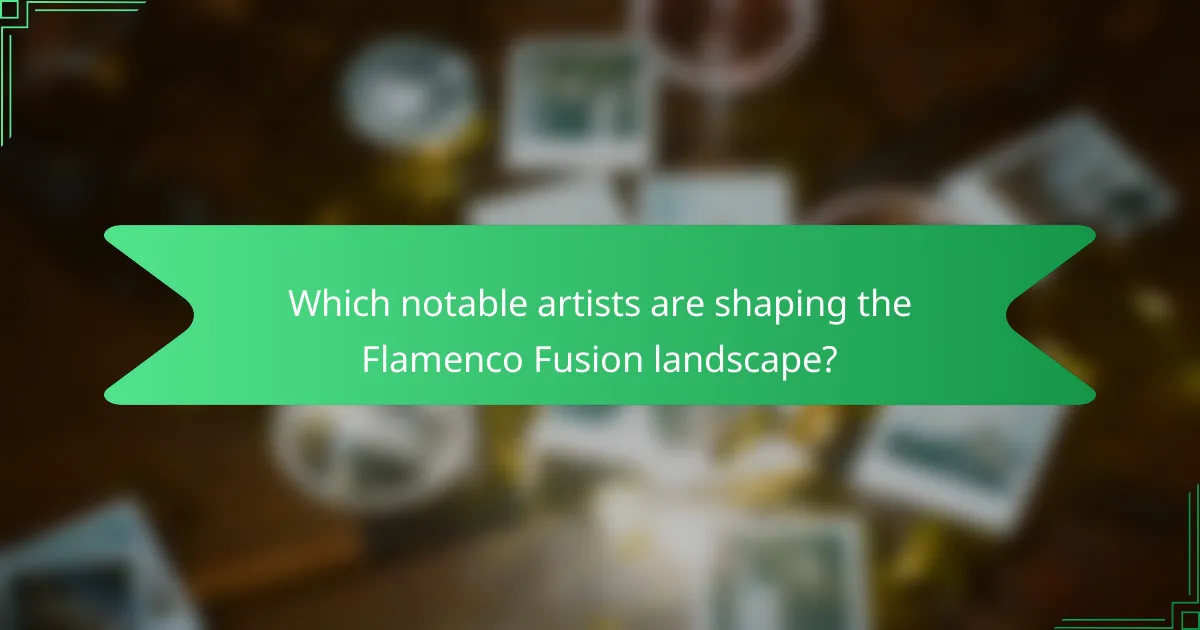
Which notable artists are shaping the Flamenco Fusion landscape?
Notable artists shaping the Flamenco Fusion landscape include Rosalía, Vicente Amigo, and Diego El Cigala. These musicians blend traditional Flamenco with various genres, enriching the cultural tapestry. Rosalía incorporates pop and urban influences, while Vicente Amigo is known for his virtuosic guitar skills. Diego El Cigala merges Flamenco with jazz and bolero, showcasing the genre’s versatility. Their innovative approaches are redefining Flamenco’s reach and significance in contemporary music.
How have contemporary Flamenco artists influenced global music trends?
Contemporary Flamenco artists have significantly influenced global music trends by blending traditional Flamenco with diverse genres. This fusion has led to innovative sounds that resonate worldwide, attracting new audiences.
Notable artists like Rosalía and Vicente Amigo incorporate elements of pop, hip-hop, and jazz, creating a unique cultural significance. Their work highlights Flamenco’s adaptability and relevance in modern music, showcasing its rhythmic complexity and emotional depth.
As a result, Flamenco fusion has inspired collaborations across genres, encouraging musicians to explore cross-cultural exchanges. This evolution demonstrates Flamenco’s impact, bridging cultural gaps and enriching the global music landscape.
What are the unique styles of individual Flamenco Fusion artists?
Flamenco Fusion artists exhibit unique styles that blend traditional Flamenco with diverse musical genres. Artists like Vicente Amigo incorporate jazz elements, while others, such as Ojos de Brujo, fuse reggae and hip-hop. Each artist brings distinct influences, creating a rich tapestry of sound that enhances Flamenco’s cultural significance.
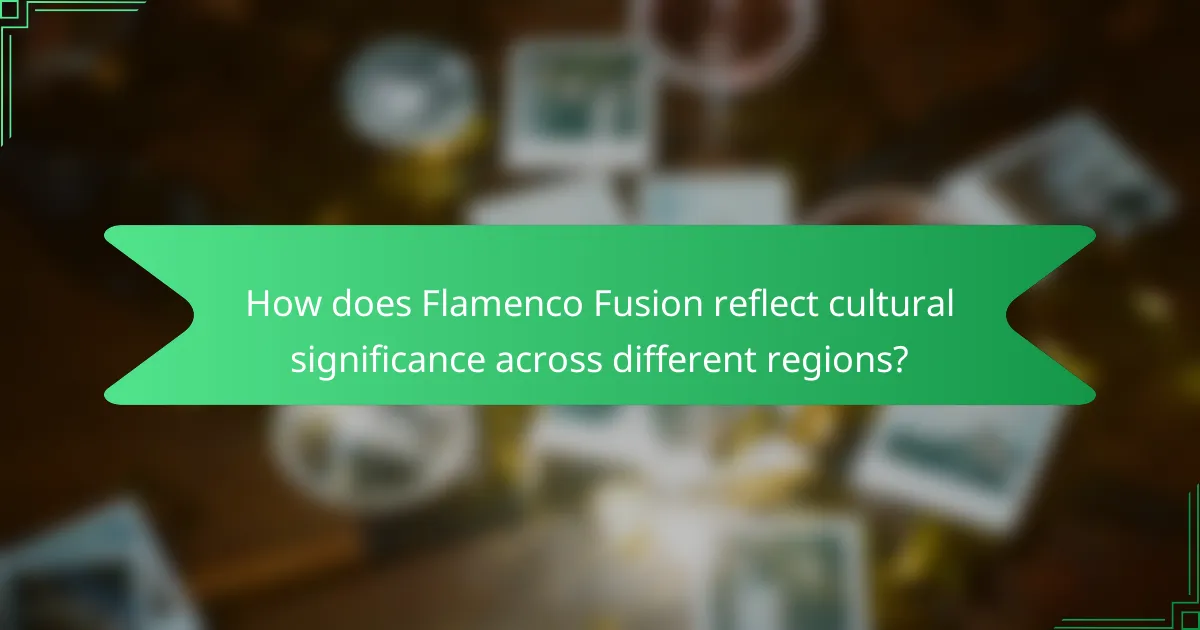
How does Flamenco Fusion reflect cultural significance across different regions?
Flamenco Fusion reflects cultural significance by blending traditional Flamenco with diverse musical styles from various regions. This fusion highlights the adaptability and evolution of Flamenco, showcasing its ability to resonate across cultures. Artists like Vicente Amigo and Tomatito incorporate elements from jazz, rock, and world music, enriching the Flamenco experience. The unique attributes of Flamenco Fusion demonstrate its role in cultural exchange, fostering a global appreciation for this art form. As a result, Flamenco Fusion serves as a bridge connecting different musical traditions and communities.
What historical influences shaped the development of Flamenco Fusion?
The development of Flamenco Fusion was shaped by various historical influences, including the integration of diverse musical styles. The migration of Romani people introduced unique rhythms and melodies, while the influence of Arabic music enriched its complexity. Additionally, the cultural exchange during Spain’s colonial period brought in elements from Latin American music, further diversifying Flamenco. Notable artists like Paco de Lucía and Vicente Amigo have blended traditional Flamenco with jazz and rock, creating a modern interpretation that resonates globally. This fusion reflects the dynamic evolution of Flamenco, showcasing its adaptability and cultural significance.
In what ways does Flamenco Fusion promote cultural exchange?
Flamenco Fusion promotes cultural exchange by blending diverse musical styles and traditions. This fusion creates a platform for collaboration among artists from various backgrounds. For example, Flamenco artists often incorporate elements from jazz, hip-hop, and world music, fostering dialogue and understanding. Such collaborations highlight shared cultural narratives, enriching the global music landscape. As a result, Flamenco Fusion serves as a bridge, connecting communities and celebrating diversity.
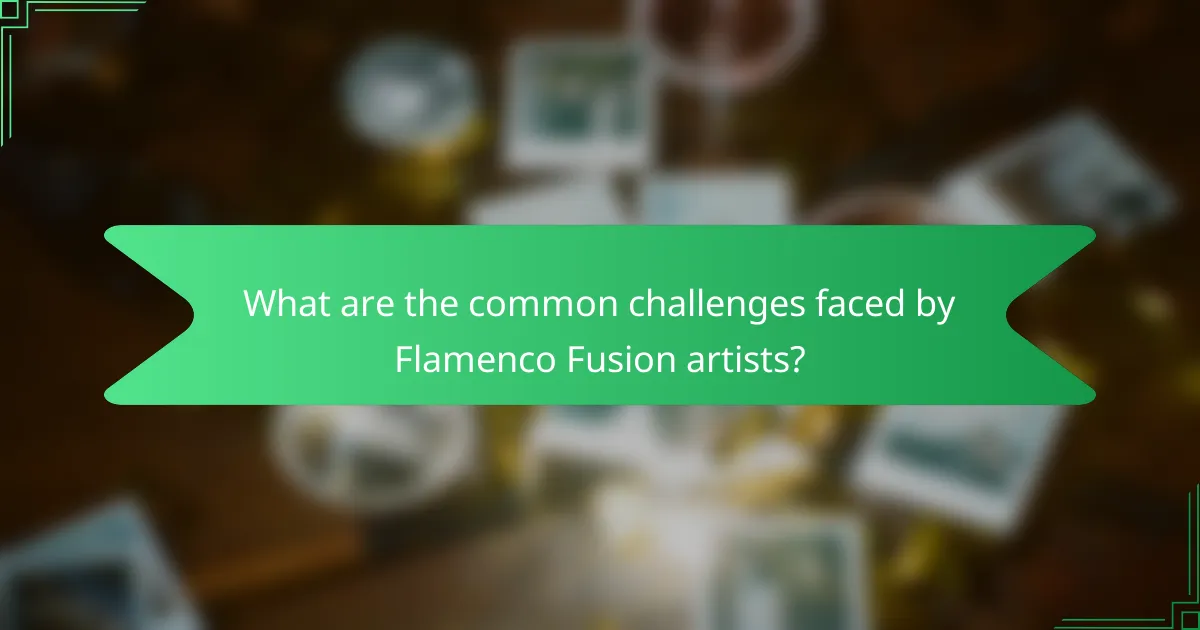
What are the common challenges faced by Flamenco Fusion artists?
Flamenco Fusion artists commonly face challenges such as blending diverse musical styles, maintaining cultural authenticity, and overcoming audience expectations. These challenges require a balance between innovation and tradition. Artists often struggle with integrating electronic elements while preserving the essence of traditional Flamenco. Additionally, collaboration with musicians from different genres can lead to creative differences, impacting the final artistic expression.
How do artists navigate the balance between tradition and innovation?
Artists navigate the balance between tradition and innovation in flamenco fusion by blending classical techniques with contemporary influences. This approach allows them to honor the roots of flamenco while exploring new artistic expressions.
Key techniques include the incorporation of modern instruments, diverse musical genres, and innovative choreography. Notable artists like Paco de Lucía and Rosalía exemplify this fusion, pushing boundaries while respecting traditional forms. The cultural significance lies in the evolution of flamenco, making it accessible to broader audiences and fostering cross-cultural dialogue.
This dynamic interplay between tradition and innovation enriches the flamenco landscape, ensuring its relevance in today’s music scene.
What are the financial and logistical hurdles in producing Flamenco Fusion performances?
Producing Flamenco Fusion performances faces significant financial and logistical hurdles. High production costs arise from securing skilled artists, quality venues, and specialized equipment. Additionally, funding for such performances can be limited, impacting marketing and promotion efforts. Logistically, coordinating schedules among diverse artists and managing travel can complicate production timelines. These challenges can hinder the overall accessibility and sustainability of Flamenco Fusion in the arts scene.
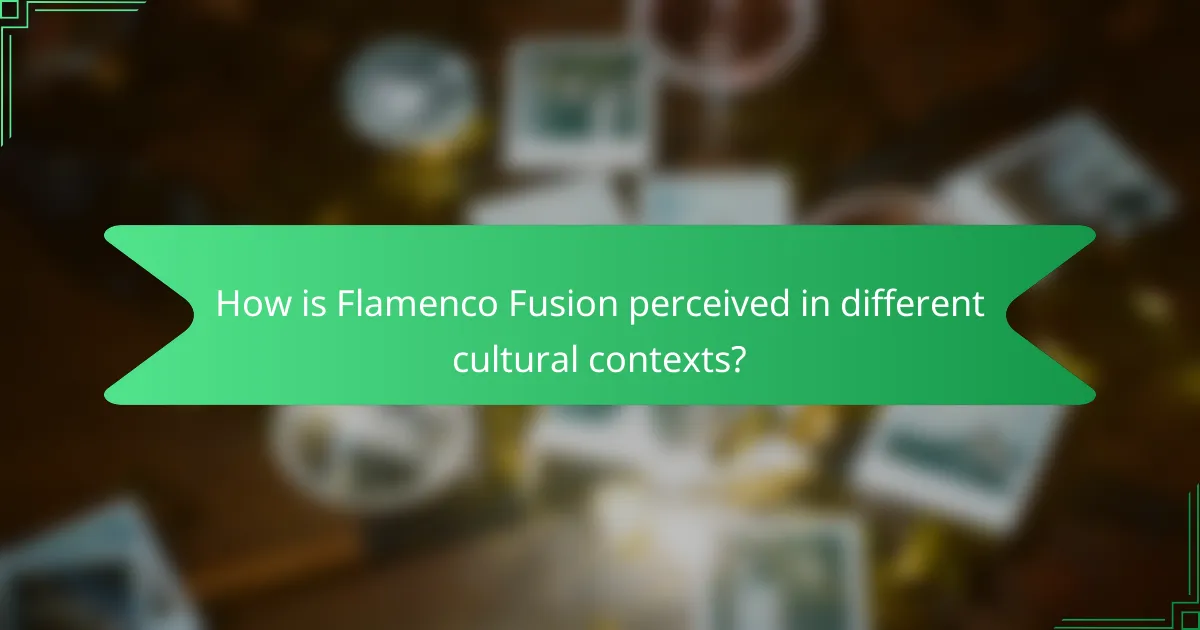
How is Flamenco Fusion perceived in different cultural contexts?
Flamenco Fusion is perceived differently across cultural contexts, reflecting diverse influences and interpretations. In Spain, it is celebrated as a modern evolution of traditional Flamenco, integrating elements from jazz and world music. In contrast, in Latin America, it is often embraced as a form of cultural exchange, showcasing local rhythms alongside Flamenco techniques. In the United States, Flamenco Fusion is viewed as part of a broader dance and music scene, appealing to audiences seeking innovation and diversity. Artists like Vicente Amigo and Tomatito exemplify this blend, enhancing the global appeal of Flamenco Fusion.
What are the audience demographics for Flamenco Fusion in various countries?
Flamenco Fusion attracts diverse audiences across various countries, influenced by cultural backgrounds. Spain, the birthplace of Flamenco, has the largest audience, primarily consisting of locals and tourists. In the United States, interest is growing, especially in urban areas with vibrant arts scenes, attracting younger demographics. Countries like Japan and Brazil show increasing appreciation, with audiences engaging through workshops and performances. These demographics reflect a blend of traditional and contemporary influences, highlighting Flamenco Fusion’s global appeal.
How do cultural attitudes towards Flamenco Fusion vary globally?
Cultural attitudes towards Flamenco Fusion vary significantly across different regions. In Spain, Flamenco Fusion is often celebrated as a modern evolution of traditional art, incorporating diverse genres. In contrast, countries like Japan view it as a unique cultural exchange, emphasizing the fusion aspect. The U.S. appreciates Flamenco Fusion as an innovative expression, blending it with jazz and contemporary dance styles. In Latin America, the focus is on its roots, acknowledging the cultural significance of traditional Flamenco while embracing fusion elements. These varying perspectives highlight Flamenco Fusion’s adaptability and global appeal.

What are the emerging trends in Flamenco Fusion for 2025?
Flamenco Fusion will see increased experimentation with electronic music and world rhythms in 2025. Artists are blending traditional Flamenco techniques with genres like jazz, hip-hop, and pop, creating innovative soundscapes. Collaborations among diverse artists are becoming more common, expanding cultural significance and audience reach. The use of technology in performances, such as augmented reality, will enhance the visual experience, attracting younger generations.
Which new genres are influencing Flamenco Fusion?
New genres influencing Flamenco Fusion include jazz, rock, and electronic music. These genres enhance Flamenco’s traditional rhythms and melodies, creating innovative soundscapes. Jazz contributes improvisational elements, while rock introduces electric instrumentation. Electronic music adds modern beats and production techniques, appealing to diverse audiences. Notable artists like Vicente Amigo and Tomatito exemplify this fusion, showcasing the cultural significance of blending genres.
How is technology impacting the production and performance of Flamenco Fusion?
Technology significantly enhances the production and performance of Flamenco Fusion by integrating diverse musical elements and innovative techniques. Digital tools enable artists to experiment with sound, blending traditional Flamenco with modern genres. Advanced audio software allows for precise editing and mixing, creating unique soundscapes. Additionally, online platforms facilitate global collaboration, connecting artists from different cultures and backgrounds. This fusion of influences enriches the genre, making it more accessible and appealing to a broader audience. The use of technology also enables live performances to incorporate visual elements, enhancing the overall experience.
What best practices can artists adopt to thrive in the Flamenco Fusion scene?
Artists can thrive in the Flamenco Fusion scene by embracing diverse techniques and cultural influences. They should focus on collaboration with musicians from various genres to create innovative sounds. Regular practice of traditional Flamenco techniques enhances authenticity while allowing for personal expression. Engaging with the community through performances and workshops builds connections and fosters growth. Additionally, utilizing social media platforms for promotion can expand their audience reach and showcase their unique style.
